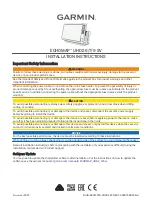
4.14. VOICE CALLS
4.14
Voice calls
To have
e-track
TM
’s
generate/terminate a voice call refer to the
XAVC
and
XAVE
messages.
To answer voice calls:
e-track
TM
default configuration is to accept a voice call when the
button is pressed. However, the unit can also be set to auto-answer
an incoming call. This is controlled by the
XAVR
command. With this
command the unit can also be configured to never take an incoming
voice call. The default configuration of
e-track
TM
is to only take calls
from numbers registered on Phone-type
Destination Points
. How-
ever, by using the
XAVI
command the unit can be set to take calls
from any number. If number-identification service is not provided by
the network operator, the authorization process can not take place
and the incoming call is rejected. The unit rejects a call by hanging
up immediately after answering it.
Number-identification-service has to be enabled for the unit’s line
by the carrier in order for the unit to answer phone calls.
Note:
To determine the incoming voice call authorization on a given
Des-
tination Point
, the C field on the Phone Number-type
DP
message is
used. Refer to the
XADP
message for more information.
To monitor the state of a voice call use the voice signals:
•
V00
: Any voice call is taking place.
•
V01
: A voice call with
DP
10 is taking place.
•
V02
: A voice call with
DP
11 is taking place.
•
V03
: A voice call with
DP
12 is taking place.
•
V04
: A voice call with
DP
13 is taking place.
•
V05
: A voice call with
DP
14 is taking place.
For example, to call
e-track
TM
, the calling party’s number has to set
on one of the unit’s phone-type
Destinations
. Let us use DP 10 to let
phone-number 3051234567 communicate with the unit:
>
SXADP10103051234567
<
An incoming call from this number will make
e-track
TM
beep every 4
seconds and make Network LED rapidly blink. (Beep indications can
be turned off). Pressing the button once will make the unit take the
88
















































